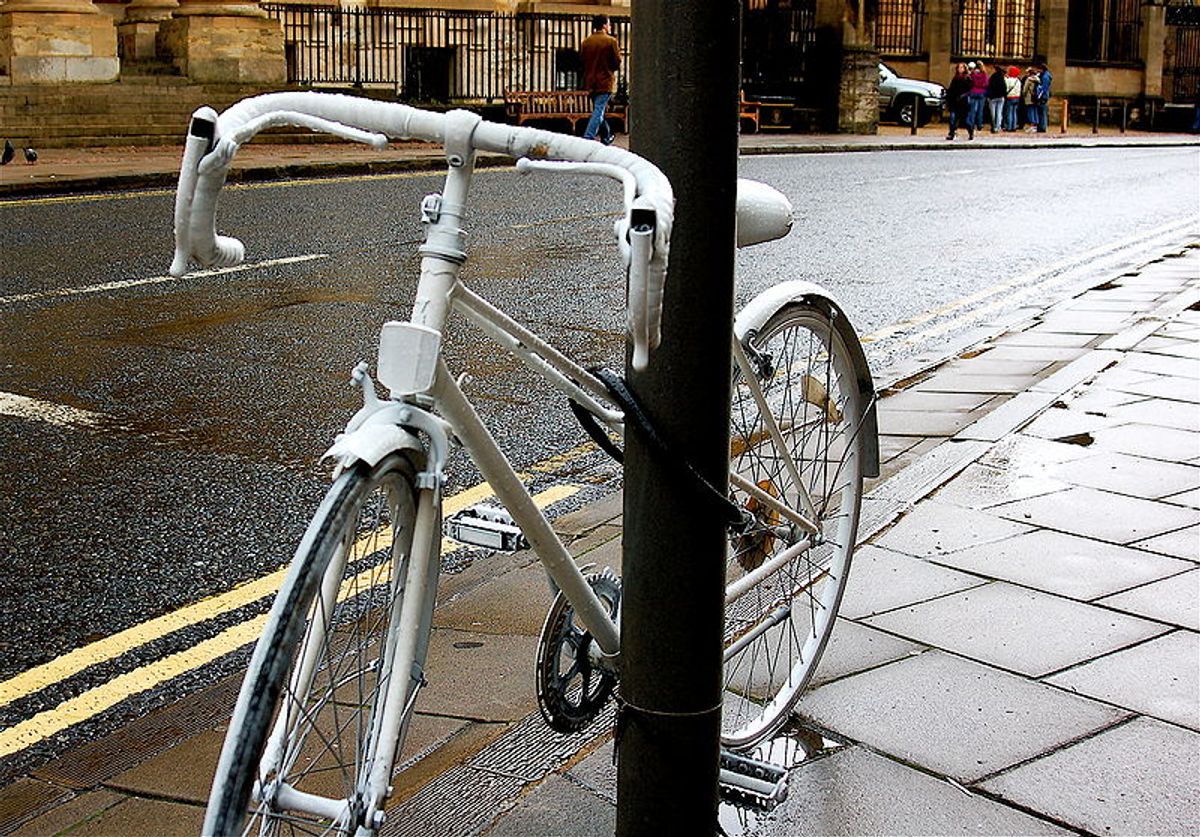 Most mornings, I get up early and ride my bicycle. I do this because I love to ride and because I could stand to get into shape. Before I leave, I kiss my wife on the cheek and tell her that I love her. She replies in a whisper, “Be safe.” This is not a heedless phrase, even if it is uttered in her less-than-conscious state. With these words she’s acknowledging that any ride may be my last. Motorists are not always looking out for bikes.
Most mornings, I get up early and ride my bicycle. I do this because I love to ride and because I could stand to get into shape. Before I leave, I kiss my wife on the cheek and tell her that I love her. She replies in a whisper, “Be safe.” This is not a heedless phrase, even if it is uttered in her less-than-conscious state. With these words she’s acknowledging that any ride may be my last. Motorists are not always looking out for bikes.
May was National Bicycle Month.This year the Ride of Silence, a Bike Week annual event, marked its tenth anniversary. The Ride began in 2003 in Dallas following the death of cyclist Larry Schwartz; it was first organized by his friends, two weeks after his funeral. One thousand cyclists participated. What began as a one-time event turned into an international phenomenon in which millions of cyclists joined at 368 registered events in all 50 states and 26 countries on six continents—a global event. This year I participated in the local event in Fort Wayne, Indiana. What struck me most—and this may be an occupational hazard—was the religious nature of it.The participants themselves recognized the solemn nature of this event. We did not speak to one another unless communicating instructions for safe travel and directions. We tied black arm bands on our left biceps in memory of cyclists who had died in collisions with motorists. We were also told that this was a funeral procession.
This fact was quite poignant to me. This winter, I job-shadowed at a local funeral home on the weekends. I did this because my professional prospects seemed bleak, and I wanted to explore career options. I performed a number of tasks, including assisting in an embalming. Most of the time I was part of the funeral procession.
So what did the Ride of Silence have in common with funeral ritual?
Funeral processions run red lights and stop signs. Cars straddle multiple lanes and command oncoming traffic to stop out of respect for the deceased and the mourners. The unique quality of the event allows for these transgressions to occur, creating what anthropologists refer to as “liminal” spaces—threshold events, existing just at that moment when people cross from one defined space to another.
Like a funeral procession, our ride inverted all established order. Escorted by police, we rode through red lights while volunteer cyclists blocked cross-traffic lanes. We flouted traffic laws and conventions in the name of proclaiming our place on the roads.
The ride also crossed geographic and social boundaries. We started at a park downtown, rode through downtown, and then entered adjacent residential areas.
The Ride of Silence, like those rituals that break down barriers between the sacred and the mundane, brought cycling not only to the financial, business, and government buildings of Fort Wayne—we also rode through neighborhoods of varying socioeconomic status: in some neighborhoods, families of color looked on as patrol cars escorted some fifty white cyclists in front of their homes; in others, people looked on appreciatively. Our riding community may not have been reflective of all demographics but the diverse assortment of settings overlapped the many uses that cycling serves for people in the city.
The Ride of Silence served to remind us of death, while celebrating life. Each of us recognized that while we are individually at risk, we occupy the lanes collectively and look out for one other’s safety. The event affirmed our cycling community and raised awareness of groups that shared a concern for cyclists’ rights. It also served as a coping strategy for the suffering that each of must embrace. That is, we come to terms with our own vulnerabilities and frailties. We ride for the love of riding. But we are all susceptible to being clipped by a vehicle, to a tire blowout, or to sliding on loose surfaces. Cycling is dangerous, and we honor the risks we take as we ride.
While I was riding my bike the next morning, I was meditating on these things. Just as I was coming to the part about recognizing our own frailties, I slid on mud and was thrown from my bike. My clips released, and my chest and knee met the pavement with extreme prejudice. I slid about five feet and was covered in mud. After picking myself up, I continued riding. Six miles later, I slipped again and fell hard on my left shoulder and left hip. I continued again for the remaining twelve miles to get home. At one point, I was waiting for a green light at a busy intersection. A man in a truck next to me made a face that communicated that my mud-bathed, blood-soaked leg looked rough. I just shrugged my shoulder and began to pedal when the light turned green.
Unlike so many others, I get to ride another day. I am reminded every day of this fact, and I will continue to participate in rituals that recognize my own frailty and honor that of others.

Shares